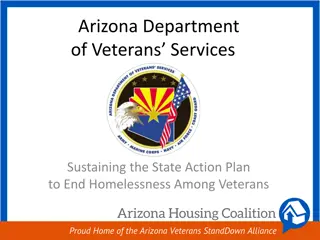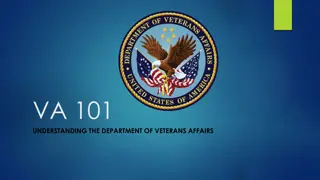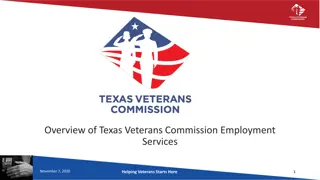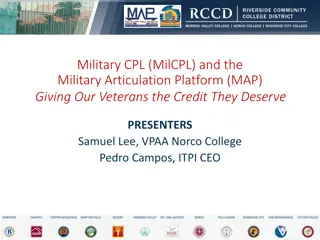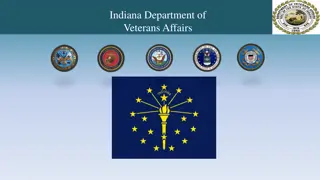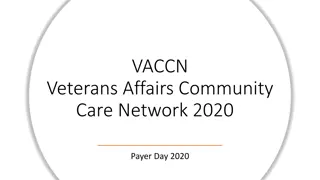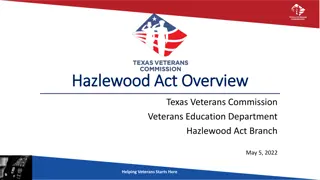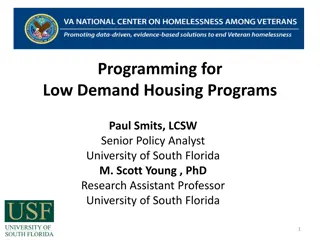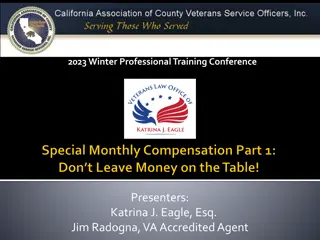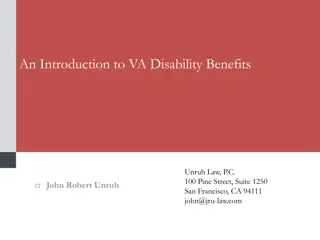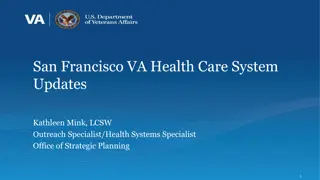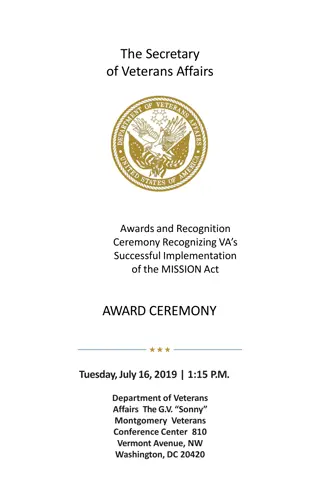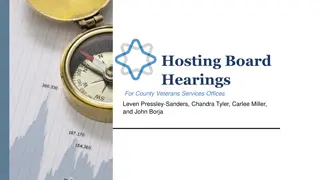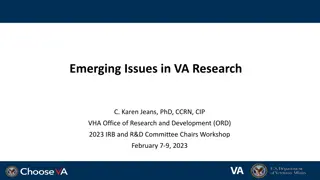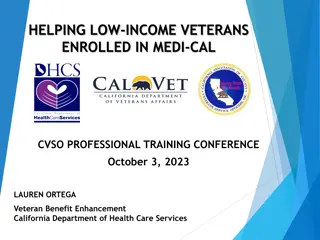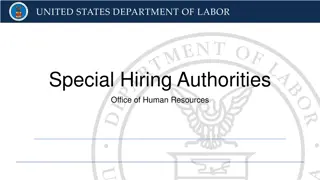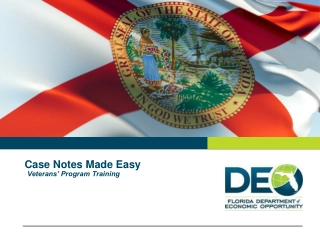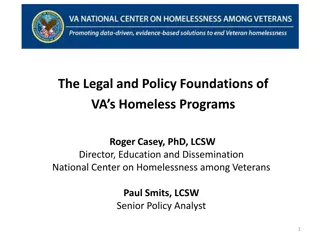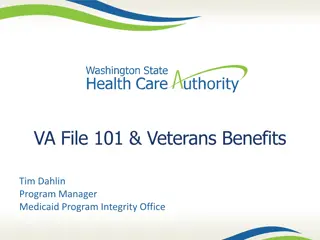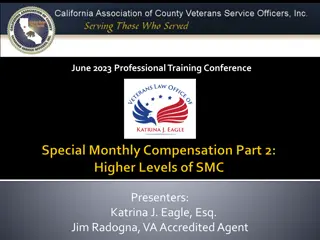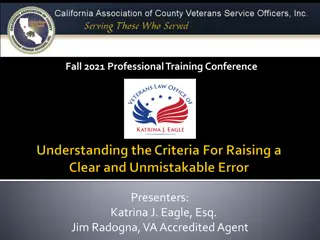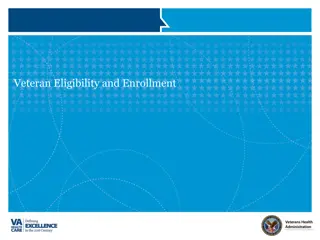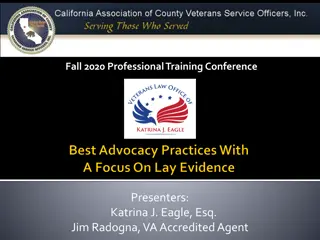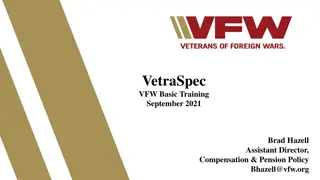Understanding CRSC and CRDP Programs for Veterans
Learn about Combat-Related Special Compensation (CRSC) and Concurrent Retirement and Disability Pay (CRDP) programs, eligibility criteria, application process, and how these programs help veterans receive rightful benefits without offsetting payments. Explore the history, prohibition on concurrent receipt, and benefits of CRSC and CRDP for veterans.
Download Presentation

Please find below an Image/Link to download the presentation.
The content on the website is provided AS IS for your information and personal use only. It may not be sold, licensed, or shared on other websites without obtaining consent from the author. Download presentation by click this link. If you encounter any issues during the download, it is possible that the publisher has removed the file from their server.
E N D
Presentation Transcript
Concurrent Receipt (CRDP) Combat Related Special Compensation (CRSC)
Objectives Objectives At the end of this session, you will be able to answer the following questions: What are CRSC and CRDP? Who is eligible for each program? How do veterans qualify for these programs? How does VA/DoD determine how much a veteran receives?
Abbreviations Abbreviations CRSC- Combat Related Special Compensation CRDP- Concurrent Retirement and Disability Pay DFAS Defense Finance Accounting Service USCG United States Coast Guard RPBOYOS Retired Pay Based on Years of Service GRP- Gross Retired Pay NRP- Net Retired Pay AEW- Audit Error Worksheet RPC- Retired Pay Center
Prohibition on Concurrent Receipt Prohibition on Concurrent Receipt and the VA Waiver and the VA Waiver Submission of an application for VA compensation constitutes a waiver of retired pay, unless the veteran checks the box on the 21-526ez negating the waiver. If a uniformed service retiree checks the box negating the waiver, VA may not pay compensation. If a veteran has waived retired pay as described above, VA will withhold retroactive VA compensation (limited to gross retired pay) and the Veteran s retired pay center (RPC) will withhold the amount of VA compensation being paid from current retired pay. This is where CRSC and CRDP come into the picture 4
Prior to CRSC and CRDP Prior to CRSC and CRDP Before 2005, there was prohibition of receipt of both VA disability pay and Military Retired Pay: if you qualified for both, they were offset. Intent: no double dipping/2 pays for same event You could choose to receive only military retired pay (no waiver) few cases where this is beneficial: usually only if disability retiree % is higher than VA% Or you could choose to waive entitlement to the amount of military retired pay equal to VA disability compensation because VA pay non- taxable 5
Prior to CRSC and CRDP Prior to CRSC and CRDP Concurrent Receipt questioned the same event issue Retired pay due to time served vs. VA comp disability: not the same event Concurrent Receipt (whether CRDP or CRSC) restores retired pay (in full or in part) that was waived in order to receive VA disability payments 6
What are CRSC and CRDP? What are CRSC and CRDP? CRDP and CRSC are Military Retiree benefits administered by the Department of Defense and Services They are not administered by VA VA s function is to check with DFAS (Defense Finance and Accounting Services) to ensure there is no overpayment CRDP and CRSC restore ONLY vested service retired pay based on longevity and still prohibits double payment of disability pay 7
What are CRSC and CRDP? What are CRSC and CRDP? Veterans can choose either CRDP or CRSC not both You can change your selection once a year at open season 8
Combat Combat- -Related Special Related Special Compensation (CRSC) Compensation (CRSC) CRSC is a special monthly benefit paid to Veterans who retired from the uniformed services and have VA service-connected disabilities deemed combat-related by the their branch of service. CRSC restores, partially or completely, retired pay that is being lost due to the VA waiver. CRSC is paid by the Defense Finance and Accounting Service (DFAS) and the U.S. Coast Guard (USGC); however, sometimes VA must reduce retroactive retired pay withholdings in order for a Veteran to receive his/her full CRSC entitlement. 9
Combat Combat- -Related Special Related Special Compensation (CRSC) Eligibility Compensation (CRSC) Eligibility NOT a VA program Veterans must submit an application through their military service branch Must be entitled to and/or receiving military retired pay For Reservists, at least 60 years old OR retired under Temporary Early Retirement Authority OR medically retired Must have VA waiver Tax free Must be receiving VA compensation for combat-related injury/condition or disability directly related to a Purple Heart (10% or more) Includes additional allowance for dependents 10
CRSC: What is combat related? CRSC: What is combat related? Injuries incurred as direct result of: Armed conflict Hazardous duty Instrumentality of war Simulated war Agent Orange exposure disabilities count Other exposure disabilities as a result of instrumentality of war (radiation, mustard gas, lewisite, etc.) also count: if not sure, file 11
CRSC: Features CRSC: Features Application-based program (must file a claim) with documentation to show disability is combat-related DoD makes determination Vet will receive special 3rd payment equal to monthly dollar- for-dollar reduction in military retired pay for combat-related disability(ies) Tax free CRSC is separate from retired pay 12
CRSC: Features CRSC: Features Court orders regarding retired pay do not include CRSC But CRSC is not VA pay, so it is subject to: Child support/alimony Garnishments Government debts 13
CRSC: What is needed for the CRSC: What is needed for the application? application? DD Form 2860 (Application) Retirement orders 20 year letter or statement of service (for reservists) Relevant pages in VA C-File or service treatment record showing disability VA rating Purple Heart award citation if applicable DD 214 14
CRSC: Application tips CRSC: Application tips The quality of the information is more important than the quantity Send copies not originals Branch will not return any documents Mail or fax to branch of service 15
CRSC: When to reapply CRSC: When to reapply A veteran may reapply for CRSC when: VA has added more disabilities to their rating that they think might qualify To reapply: Visit branch of service website for the reconsideration form 16
CRSC Payable CRSC Payable For veterans in receipt of retired pay based on years of service (RPBOYOS), the amount of CRSC payable is the amount payable for the combined evaluation of the Veteran s service-connected (SC) combat-related (CR) disabilities (Limited to Gross Retired Pay (GRP)). Example: Gross Retired Pay: $2,000 Gross VA Compensation payment: $2,200 CRSC: $2,200 (All disabilities are combat related) CRSC Payable: $2,000 17
CRSC CALCULATIONS FOR DISABLED CRSC CALCULATIONS FOR DISABLED RETIREES (Medical Board Retirees) RETIREES (Medical Board Retirees) For CRSC Eligible Disability Retirees, Concurrent Receipt is Limited to RBOYOS Example: GRP: $1,600 RBOYOS: $600 Gross VA compensation payment: $1,100 CRSC: $1,100 (all disabilities are combat related) Concurrent Receipt is limited to $600 Net Retired Pay (NRP) (GRP GVA) = $500 Therefore, CRSC is $100 The Veteran will receive $1,100 from VA and $600 from DFAS ($500 in Retired Pay and $100 in CRSC) 18
Concurrent Retired and Disability Concurrent Retired and Disability Pay (CRDP) Eligibility Pay (CRDP) Eligibility CRDP is a program which allows concurrent receipt of uniformed service retired pay and VA compensation. Veterans must have a combined VA service-connected evaluation of at least 50% and be retired based on longevity* or retired due to disability with at least 20 years of service. CRDP is not a special payment; rather, it is included with Veterans military retired pay. As with CRSC, sometimes VA must reduce retroactive retired pay withholdings in order for a Veteran to receive his/her full CRDP entitlement. *Veterans retired under the Temporary Early Retirement Authority (TERA) are retired based on longevity. 19
CRDP Amount CRDP Amount Veterans in receipt of RPBOYOS receive the full amount of their retired pay and VA compensation if their VA compensation rating is 50 percent or greater. Example: (CRDP based on RPBOYOS) RPBOYOS: $1,400 Gross VA (GVA): $950 $1,400 (RPBOYOS) + $950 (GVA) = $2,350 20
CRDP for Medically Retired CRDP for Medically Retired Reservists Reservists Medical retirement only counts active duty time If the veteran served 20 good years in the reserves but was medically retired with less than 20 years active duty, the veteran must wait until age 60 to qualify for CRDP The veteran may qualify for CRSC before age 60 if there are any combat related disabilities 21
CRDP Process CRDP Process No application required; DFAS automatically determines eligibility Must waive military retired pay in favor of VA compensation Military payments are taxable (DFAS statement); VA benefits are not taxable Will receive gross retired pay, not 3rdpayment 22
CRDP Features CRDP Features CRDP is essentially a substitute for a portion of military retired pay that must be waived Because it is a restoration of retired pay and is not VA pay, the gross amount of CRDP may be reduced for Taxes Child support/alimony Garnishments Government debts 23
Audit Error Worksheet (AEW) Audit Error Worksheet (AEW) VA releases retroactive retired pay withholdings due veterans as a result of CRSC/CRDP entitlement via the AEW process: 1. VA promulgates an award and withholds retroactive compensation 2. The VA award lines are transmitted to DFAS/USCG via a bi-weekly combined interface file (CIF) 3. DFAS/USCG determines CRSC/CRDP eligibility and calculates amounts due 24
Audit Error Worksheet (AEW) Audit Error Worksheet (AEW) continued continued 4. If DFAS/USCG determines amounts are due from VA, they send VA an audit DFAS transmits audits to VA in a single file during the first week of each month USCG sends audits to VA on a CD via US mail once a month 5. VA transforms the audit into an AEW DFAS AEWs are automatically uploaded into VBMS and a work item is automatically established on each AEW USCG AEWs are manually uploaded into VBMS and VAROs are notified via email that the AEW needs to be worked 25
AEW Payment AEW Payment Normally it takes approximately 35 to 100 days from the date of the VA award action to receipt of the audit from DFAS. However, most audits are received approximately 65 days from the date of the VA award action. DFAS does not send VA audits one at a time. DFAS does not send VA audits on a day other than a day during the first week of the month Most AEWs are processed automatically within 24 hours of the date the audits are received from DFAS. Payment will be made within 5-7 days. AEWs not automatically processed must be manually processed. 26
Taxes and VA benefits Taxes and VA benefits If an award of CRSC or CRDP results in a reduction of tax liability (veteran was paid taxable retired pay and should have been paid non-taxable VA or CRSC), the veteran can file an amended tax return The Court case allowing an amended tax return for retroactive VA awards is called the Strickland decision and Revenue Ruling 78-161 DFAS will not send an amended 1099-R for retro years, only for the present year Consult a tax professional to determine whether to file amended return: Military retirees may go to the legal assistance office/tax center on many bases for help 27
Program Comparison Program: VA Rating CRSC CRDP 50% or greater Not required Compensable Combat-Related Qualifying Disability Retired based on longevity (Generally 20 years of Active Duty unless TERA Retiree). Disability Retirees must have at least 20 years of service. 20-Year Retirement Letter for Reservists Must be eligible to receive retired pay (either based on longevity or disability) Eligibility Criteria Taxable Yes No Must Apply Automatic Application Requirements Subject to Garnishment, child support Yes Yes No. VA offset is reduced. Separate Payment Yes Subject to Former Spouse Protection Act (FSPA) Yes No 28
Frequently Asked Questions Frequently Asked Questions 1. Is a Veteran who retired under the Temporary Early Retirement Authority with less than 20 years of service eligible for CRDP? Answer: Yes, provided the Veteran has a combined service- connected evaluation of 50% or greater. 2. Can a Service member apply for CRSC prior to being discharged? Answer: No. A VA rating decision is required before applying for CRSC. 3. Is a Reservist with a 20-year letter who is in receipt of disability retired pay eligible for CRDP prior to age 60 or the eligibility age applicable under 10 U.S.C. 12731(f)(2)(A)? Answer: No. Such a retiree would not be eligible for CRDP until reaching age 60, or the eligibility age applicable under 10 U.S.C. 12731(f)(2)(A). 29
Frequently Asked Questions Frequently Asked Questions 4. If a disability retiree is in receipt of VA compensation and their branch of service determines that one or more VA service connected disabilities are combat-related, will they receive CRSC? Answer: Maybe. For disability retirees, if Net Retired Pay (GRP GVA) is greater than or equal to RBOYOS, CRSC is not payable. 5. If a veteran doesn t agree with the amount of CRSC received, should they contact VA? Answer: No. VA does not pay or calculate CRSC. They should contact their retired pay center. (DFAS or CG) 30
CRSC/CRDP Fast Facts CRSC/CRDP Fast Facts CRDP CRSC Veterans must have a combined VA disability evaluation of 50% or more and be retired due to longevity. Disability retirees must have at least 20 years of service. CRDP is considered retired pay, is taxable, and is not a separate payment. It benefits the Veteran by increasing net retired pay. Payment is determined by the Defense Finance and Accounting Service (DFAS) or Coast Guard (CG). Any combat-related, compensable service-connected disability. CRSC is not retired pay and is a tax- free entitlement that is paid separately from VA disability compensation and retired pay. Enrollment is not automatic. Veterans must apply to their branch of service CRSC board (DD Form 2860). Payment is based on VA compensation rate tables (20% CRSC=20% rate from VA rate tables). 31




